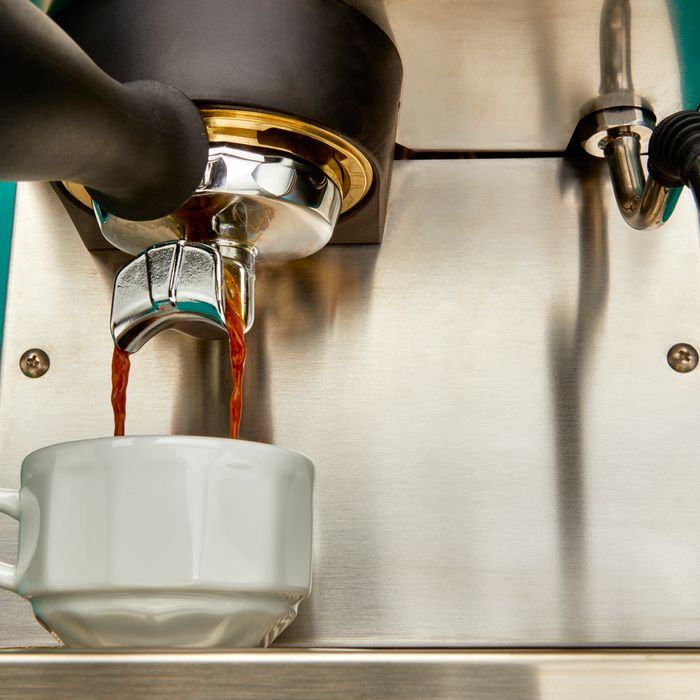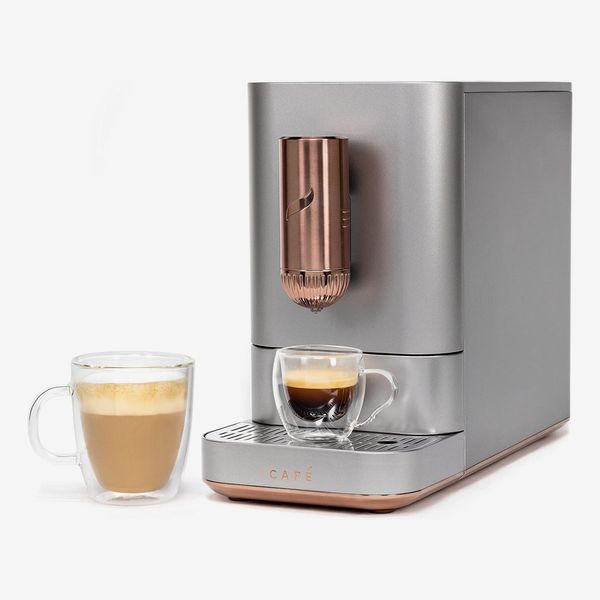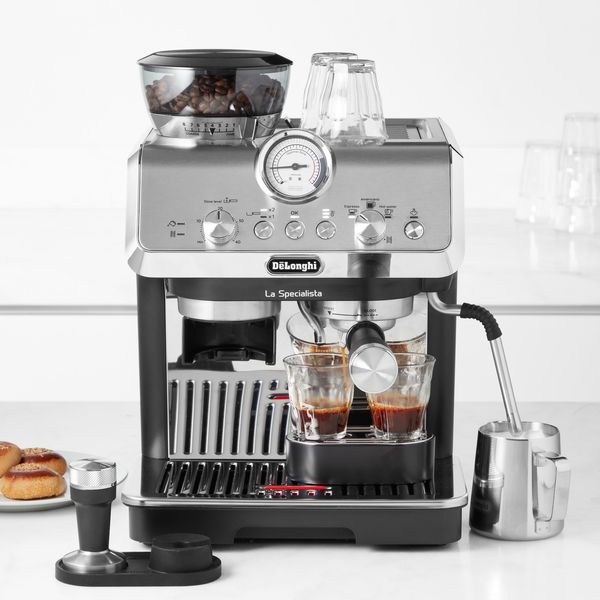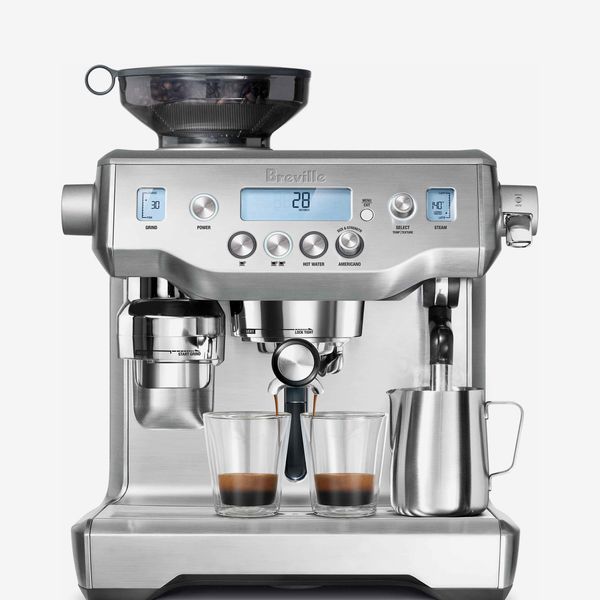
In this article
While testing espresso machines and interviewing experts for this article, one thing has become very clear to me: Making quality espresso at home can be tough. It’s not that it’s not worth doing; it’s just that if you have an espresso habit routine enough to warrant a home setup, you probably care about how good your espresso tastes. And if you care about how good your espresso tastes, you’re likely going to need to invest some real money into the whole production.
“My first question when people tell me they want to make espresso at home is ‘Why?,’” Kyle Ramage, co-owner of Black & White Coffee Roasters in Raleigh, North Carolina, told me. “The most common answer I get is to save money. But the reality is, if you’re not willing or able to spend a decent amount, you’re not going to get equipment worth owning.” The market for espresso equipment simply isn’t the same widely populated and overall-impressive field as standard coffee makers, but while Ramage’s view is, in my mind, too unconditional, it serves as a bit of a disclaimer for the list below.
This list includes machines from some of the best-known brands in the space, including Breville and La Marzocco. The most-lauded option — the one where you’re truly going to get cafe-grade shots and beautifully frothed milk — is well over $5,000. That said, my favorite machine which I tested with great results — our best overall pick — comes in at $600. There are several budget-friendly picks (include one I’ve used and love) that are different in nature than a big shot-pulling machine, too, like a convenient pod-based Nespresso that two everyday espresso drinkers swear by, and a couple of stovetop moka pots that will give you a perfectly delicious latte. And if you’re interested in exploring a straight-ahead coffee maker (or any of the best coffee gear I’ve rounded up, like grinders, milk frothers, and electric kettles), you can read my guides to those, too.
Update on December 19, 2024: Updated prices and checked stock for all products.
What we’re looking for
Components
If the machine comes with a milk frother. it might have a “dual boiler,” which means you can pull your espresso shot and froth your milk at the same time. This, as Jerad Morisson, co-founder and co-CEO of Sightglass Coffee in San Francisco, explains, “really helps temperature and pressure stabilization so that the machine is dependably at optimal brewing and steaming settings.” If it doesn’t, however, you have to make your coffee and your milk one after the other. Some machines have a coffee grinder built in (which can be helpful for saving space and money, since individual ones don’t come cheap). For others, you’ll need to buy a separate one.
Size
To help you determine whether the espresso machine fits in your space, I’ve listed the dimensions of each.
Best espresso machine overall
Components: No dual boiler, no built-in grinder | Size: 12.3” x 10.1” x 13.1”
The Breville Infuser is easier to use and significantly less expensive than the higher-end machines on this list, and it produces great, consistent shots. While making espresso is, by nature, finicky, if you get your beans to the right grind size, weigh them properly, and use one of the included double-walled portafilter baskets built to pressurize the coffee, you should get a smooth brew just like I did. (Technically, the included single-walled ones get even more nuanced with the taste they can produce, a plus for people who want to get really into the process, but the difference is not something I noticed as a non-aficionado.)
The Infuser also allows you to program the one shot and two shot buttons: If you measure out your ideal brew once, you can set the timing so you have a uniform extraction each time. (Here’s a short but more in-depth explainer to better understand how to work this feature.) And I love the magnetic slot that holds the tamp neatly in place.
As an espresso-making novice, I found the Infuser user-friendly with super clear designations for everything. I used a fancy La Marzocco every so often at my old job and tested the industry-approved Rancilio Silvia, both below — but the Infuser was far easier to handle than both machines on first go.
Turns out, Breville is pro-approved, too. “[Their] home machines are some of the best you can get in terms of user experience and customer service,” says Ramage. And nearly every other expert I talked to seems to agree. While truly serious coffee people (like the experts themselves) might invest in the higher-end items on this list, the average person isn’t likely to be so hyper-aware of espresso nuances. So, Breville it is, for my best overall pick. They’re all around well-performing espresso machines with a generally wide range of capabilities in a wide range of price points (that’s why you’ll see multiple models of theirs on this list).
I went with this model for the best espresso maker overall because it was named specifically by Suarez, who calls it “a great entry model.” Both the Bambino and the Bambino Plus are cheaper with the former retailing at $300 and the latter at $500 — but this one is still on the lower end of the spectrum for the brand and therefore relatively accessible.
Best less expensive espresso machine
Components: No dual boiler, no built-in grinder | Size: 16.25” x 5.5” x 12.75”
If you’re interested in something even simpler that doesn’t require weighing grounds or tamping, consider this single-serve pod-based machine. Two coffee and espresso aficionados, textile designer Caroline Hurley and clothing designer Alex Crane keep one on their kitchen counter “because it’s just so easy,” Hurley says. It’s a completely different style than the Breville, but one that we’re designating the best less expensive because it can’t be beat in terms of price and simplicity. Instead of needing to learn how to pull a smooth shot, this one operates by placing a Nespresso pod into a slot (both Hurley and Crane use the espresso ones, but you can also buy them in coffee form) and clicking a button. The maker heats and brews in a matter of seconds, automatically depositing the used pod in a container at the back that you can empty and recycle (with some specific guidelines).
Hurley likes that you can buy a big variety of flavors that they’ll send to you in a tester pack — “like jelly beans but for coffee,” she says — so you can determine your preferences. “And honestly, they taste deep and flavorful,” she says. “I don’t think grinding whole beans makes much of a difference.” Crane says he appreciates that the maker brews with what he calls “a gentle sound, unlike some others that sound so loud and sinister,” as well as the fact that it only produces one cup at a time so he can watch his consumption. “If there was a full French press, I would drink all of it,” he says.
If you’re interested in a much less expensive (and portable) single-serve espresso maker, the $40 Aeropress comes recommended by the two coffee pros who praise it for its low-acidity brew and durability.
Best portable espresso machine
Components: No dual boiler, no built-in grinder | Size: 4.17” x 3.07” x 2.8”
The Picopresso is marketed as a portable model that is especially good for travel, but there’s no reason it can’t be employed at home. Its super-compact size — much smaller than the Breville and the Nespresso — might even be essential for people with small kitchens who are still dedicated to having an espresso option.
“We actually crowdsourced this one in our work Slack channel,” Suyog Mody, founder of Brooklyn’s Driftaway Coffee, told me. “Several people on the team strongly endorse it. I feel like it’s sort of an industry secret.” The Picopresso works with manual hand pressure, meaning that one essential part of the espresso-making process is generated via the person brewing instead of the machine. According to the company, you just have to dial in the correct grind size and tamping (something you have to do with electric models anyway) — and then perfect your pulling technique, a skill that seems well worth the learning curve for an espresso maker that costs not much more than $100 and still makes a stellar shot.
Best compact espresso machine
Components: No dual boiler, built-in grinder | Size: 7.09” x 16.1” x 12.48”
The Café Affetto is only seven inches across, less than any other more permanent setup on this list. (The portable Picopresso above and the stovetop options below are both smaller.) Strategist associate editor Jenna Milliner-Waddell says it sits perfectly on the small bit of counter space she has.
“It couldn’t be easier to use thanks to the automatic grinder,” Milliner-Waddel says. “You put whole espresso beans in, fill the reservoir with water, and it grinds and brews the perfect shot.” It also features a steam wand, which Milliner-Waddel says heats all brands of oat and almond milk just the same. Perhaps most impressive of all, though, is the machine’s smart capabilities. It prompts you to clean and descale it, she says, so you never forget upkeep, and it has app compatibility that allows you to pre-program your preferred settings.
Best stovetop espresso machine
Components: No dual boiler, no built-in grinder | Size: 7.5” x 8” x 4.5”
A moka pot doesn’t technically make espresso, but is still often described as a “stovetop espresso maker” — meaning it’s a reliable way to make delicious espresso-like drinks at home without any fuss. Ken Nye, owner of Ninth Street Espresso, explains that this is because “the result is still concentrated and full bodied.”
I’ve used the Bialetti many times and love it. It’s a classic Italian model, though there are also many out there to choose from. No matter the brand, moka pots take super finely ground beans, just like espresso machines, and generate a liquid prime for being mixed with milk. Marco Suarez, one of the owners of Methodical Coffee in Greenville, South Carolina, endorses them, too, saying, “I think they’re really cool. I don’t know if they can do the exact concentration of a machine, but they get pretty close if you’re just trying to replicate a good cappuccino or latte at home.” And one final endorsement: Isabella Rossellini makes two espressos a day with her Bialetti, an item she says she can’t live without.
Best stovetop espresso machine for shots
Components: No dual boiler, no built-in grinder | Size: 5” x 6” x 3”
For a Bialetti with slightly different functionality, try this model with two spouts. It still percolates from the heat underneath a burner, but dispenses directly into two glasses instead of a larger compartment up top. “It’s great because it really does pull shots, rather than feeling like a small cup of very strong coffee,”says New York Times movie critic and espresso fan Alissa Wilkinson. “Also, often my husband will make espresso and then just bring me the little cup, which is efficient and fun.” Additionally, she points out that, just like the classic model above, no mechanical parts means it’s “fairly indestructible,” “simple to clean,” and can be “squirreled away most anywhere or packed for AirBnb purposes.”
Best espresso machine that also makes coffee
Components: No dual boiler, no built-in grinder | Size: 12” x 8.75” x 15.04”
This machine bills itself as a coffee maker — but it has what the brand calls a “specialty” button to make coffee concentrate, similar to the full-bodied liquid the moka pot creates that’s especially good for lattes and cappuccinos. (There’s an attached milk frother for making those drinks, too.) Strategist writer Arielle Avila uses the setting regularly and says it “definitely tastes stronger than regular coffee and is thicker.” It doesn’t quite have the same creaminess as true espresso, she admits, “but I still think it’s a win for the price point and convenience.”
Best espresso machine with built-in grinder
Components: Grinder, no dual boiler | Size: 13.9” x 16.1” x 16”
The Breville Barista Pro is comparable to the high-end Rancilio Silvia (below) in price point, but comes with an additional piece: a built-in grinder. For his part, Suarez says, “I don’t necessarily think you need one. When you have less going on in one machine, you can kind of optimize for each thing. If the grinder breaks, you’re screwed a little bit.” But I think it’s also worth noting that a good espresso maker and a grinder for $800 is really quite affordable, as standalone grinders can also cost quite a bit.
Best less expensive espresso machine with built-in grinder
Components: Grinder, no dual boiler | Size: 14.25” x 11.25” x 15.75”
The De’Longhi La Specialista Arte is an even more affordable machine with a built-in grinder. And for his part, Hugo Murray, co-founder of New York City’s Butler, is a pro who stands by this feature, especially for people who are short on space. He’s used this machine at home for nearly a year. (Both the Breville and De’Longhi are the only picks on this list with a built-in grinder and no dual boiler.) “The grinder is easy to adjust, shots pull well, and the steam wand allows for good texturing,” he says, referring to the high amount of pressure it emits to create “a silky thickness all the way through” the milk. He also points out that all the removable parts are dishwasher safe so it’s easy to keep clean.
Best espresso machine with dual boiler
Components: Dual boiler, no grinder | Size: 17.3” x 17.3” x 20.2”
As explained above, a dual boiler means you can simultaneously brew your espresso and froth your milk, each function heated to the exact degree it should be. Not only this, but without one, as McCarthy notes, “there’s a little bit of a time delay. If you steam your milk first, you have to wait for the boiler to cool down so it doesn’t burn your coffee. If you make your coffee first, you have to wait for it to heat up before you steam your milk.” This machine goes up several inches in size, so you’ll want to make sure you have the space for it.
Best espresso machine with built-in grinder and dual boiler
Components: Dual boiler, built-in grinder | Size: 14.5” x 14.7” x 17.6”
If you really want an all-in-one machine — meaning a dual boiler and a built-in grinder — the Breville Oracle is the way to go, named specifically by Ramage and Cary Wong, a member of the Partners Coffee education team. It is, surprisingly, slightly smaller than the Dual Boiler, so if space is an important consideration (especially given that with the Dual Boiler, you’ll have to get an additional piece of equipment), it might be the perfect fit. Wong also says he wouldn’t worry too much about getting a separate grinder: “If you’re a regular consumer, it’s really useful and convenient.”
Best high-end espresso machine
Components: Dual boiler, no built-in grinder | Size: 6.7” x 5.6” x 4.0”
Far and away, the espresso-maker the pros recommended to me most is the Linea Mini. This isn’t too surprising, as it’s “literally a commercial machine at home,” says Wong. What he means is that it’s made of parts that go into La Marzocco’s industry-standard cafe-grade machines — only smaller. And unlike the Rancilio Silvia below, which is also built from super high-quality parts, the Linea Mini has that dual boiler I’ve talked so much about, which really puts it over the top. It’s also, we know, over the top in price, several thousand dollars more than the top-of-the-line Breville. In other words, it’s not so much for the casual (or even semi-casual) espresso drinkers among us. But it also would have been a glaring omission in the world of espresso to leave it off this list. Not only is it “aesthetically beautiful,” as Wong says, but it’s also quite customizable; you’re able to choose the color of the feet, the style of the knobs, and more. “There is no other machine that is as durable and that can consistently make perfect coffee shot after shot,” says Morisson.
La Marzocco recently released an even more compact model, the Linea Micra, which the brand calls a “true home espresso machine.” It’s still expensive at a couple thousand dollars less than the Mini, but its build and functionality are very similar. The most notable differences, aside from the placement of certain buttons and indicators, are the smaller steam boiler and water reservoir; you have to fill the reservoir more often, but the appliance heats up faster. (If you want to directly compare the features and specs of all La Marzocco’s offerings, take a look here.)
If (for some reason) you want an even more professional setup than the Mini, you can buy La Marzocco’s GS3 for an additional $2,000. Morrison explains the difference: “Whereas the Linea Mini is more analog, the GS3 has a full-feature electronic interface that allows the user to fine-tune and program coffee brewing settings to their preferences.”
Best less expensive high-end espresso machine
Components: No dual boiler, no built-in grinder | Size: 9.2” x 11.4” x 13.3”
The Rancilio Silvia Espresso Machine is markedly less expensive — $3,035 less expensive, to be exact — than even the Linea Micra. This is in large part due to the fact that it doesn’t have a dual boiler, and that it doesn’t deliver quite as sleek of a design with all those customizable parts. Indeed, it’s more difficult to operate: People who opt for a Rancilio Silivia are generally obsessive about technique (there are tricks you can learn and separate parts you can buy to better control temperature, which the machine doesn’t do automatically, discussed at length on forums like Reddit). In short: It’s for the real coffee nerds. While the machine has three clear settings (one for hot water, one to pull shots, and one to activate the steam wand), in giving it my own best go, there was certainly a learning curve. (I watched a few instructional videos like this one, and did a slightly deeper dive into “temperature surfing,” the method used to regulate degrees.) At first, my tries yielded espresso that was too dark and bitter — but I finally got decent ones by applying the right amount of pressure to my tamping and getting the hang of temperature surfing.
If that’s who you are, it comes enthusiastically recommended by Wong, as well as Mody and James McCarthy, coffee educator, at Brooklyn’s Driftaway Coffee. “Rancilio used to make commercial machines,” Mody says. “They created this one to send to their distributors and give away at trade fairs. But it ended up so popular that they decided to release it to the consumer market.”
And though I wouldn’t necessarily recommend this machine for total newbies like myself (unless you’re committed to learning a ton), there are some immediately noticeable appealing features. It has a flat tray at the top to store mugs and glasses, and the bottom plate is easy to slide off and clean thoroughly. Mody also says that while all espresso makers generate noise, this one is on the quieter side. And perhaps most notable of all, it’s shorter than any of the other electric machines on this list besides the best compact machine — key if you have low cabinets.
Some other coffee makers we’ve written about
Our experts
• Arielle Avila, Strategist writer
• Alex Crane, clothing designer
• Caroline Hurley, textile designer
• James McCarthy, coffee educator at Driftaway Coffee
• Jenna Milliner-Waddell, Strategist associate editor
• Suyog Mody, founder of Driftaway Coffee
• Jerad Morisson, co-founder and co-CEO of Sightglass Coffee
• Hugo Murray, co-founder of Butler
• Ken Nye, owner of Ninth Street Espresso
• Kyle Ramage, co-owner of Black & White Coffee Roasters
• Marco Suarez, co-owner of Methodical Coffee
• Alissa Wilkinson, New York Times movie critic
• Cary Wong, Partners Coffee education team
The Strategist is designed to surface the most useful, expert recommendations for things to buy across the vast e-commerce landscape. Some of our latest conquests include the best women’s jeans, rolling luggage, pillows for side sleepers, ultra-flattering pants, and bath towels. We update links when possible, but note that deals can expire and all prices are subject to change.
Every editorial product is independently selected. If you buy something through our links, New York may earn an affiliate commission.
























